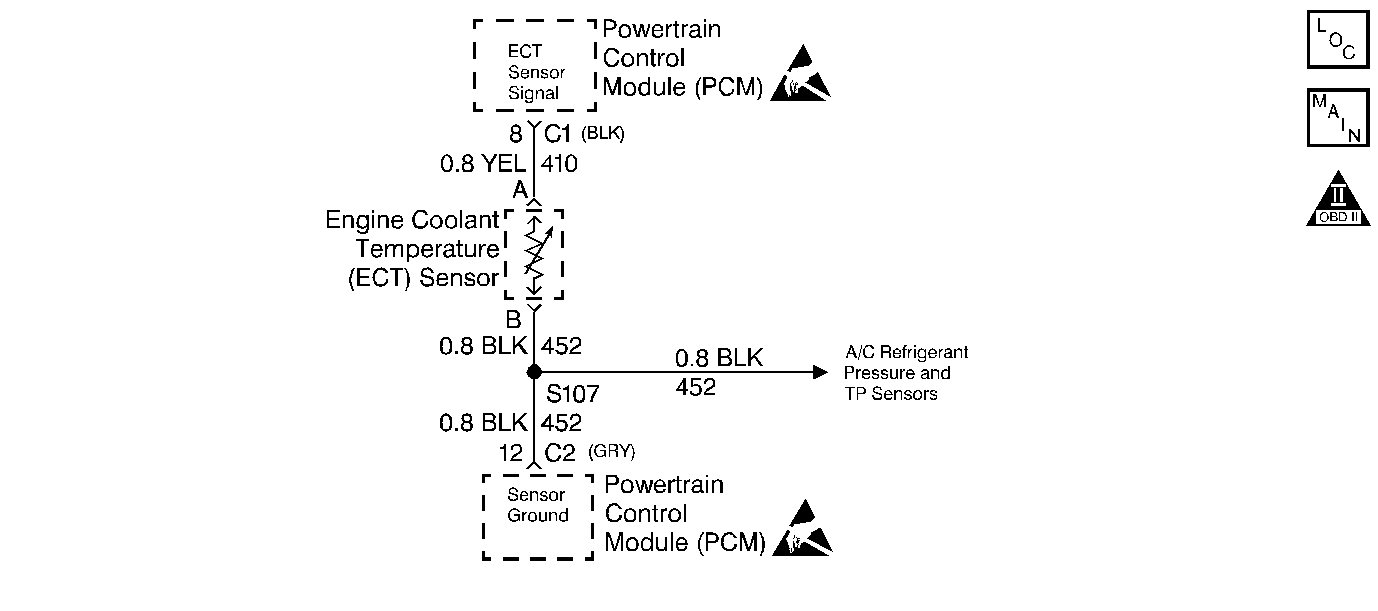
Circuit Description
The Engine Coolant Temperature (ECT) sensor is a thermistor which controls the signal voltage to the Powertrain Control Module (PCM). The PCM supplies a 5 volt reference and a ground to the ECT sensor. Whenever the engine is cold, the ECT sensor resistance will be high.
As the engine warms up, the ECT sensor resistance decreases and the voltage drops. At the normal engine operating temperature, the voltage will be between 1.5 and 2.0 volts.
The engine coolant temperature sensor is one of the inputs used to control the following items:
| • | The fuel delivery |
| • | The Torque Converter Clutch (TCC) |
| • | The Ignition Control (IC) |
| • | The Evaporative Emission (EVAP) canister purge valve |
| • | The Idle Air Control (IAC) valve |
Conditions For Setting The DTC
| • | The engine run time is greater than 128 seconds. |
| • | The ECT sensor indicates that the engine coolant temperature is greater than 138°C (280°F). |
Action Taken When the DTC Sets
| • | The Malfunction Indicator Lamp (MIL) illuminates. |
| • | The PCM records the operating conditions at the time the diagnostic fails. The Freeze Frame and Failure Records buffers stores this information. |
| • | A history DTC is stored. |
| • | The PCM defaults to 20°C for the first 60 seconds of engine run time. After 60 seconds the ECT will default to 92°C for engine coolant temperature. The scan tool will not show the defaulted value. |
Conditions for Clearing the MIL/DTC
| • | The malfunction indicator lamp (MIL) will turn OFF after 3 consecutive ignition cycles in which the diagnostic runs without a fault. |
| • | A history DTC will clear after 40 consecutive warm up cycles without a fault. |
| • | Use a scan tool to clear the DTCs. |
Diagnostic Aids
After the engine has started, the ECT should rise steadily to about 90°C (194°F) then stabilize when the thermostat opens.
Test Description
The numbers below refer to the step numbers on the diagnostic table.
-
The Powertrain OBD System Check prompts the technician to complete some basic checks and store the Freeze Frame Data and the Failure records on the scan tool if applicable. This creates an electronic copy of the data taken when the fault occurred. This information on the scan tool can be referred to later.
-
Before replacing the PCM, check terminals for improper mating, broken locks, or physical damage to the wiring harness. Reprogram the replacement PCMs. Refer to the latest Techline information for programming procedures.
Step | Action | Value(s) | Yes | No |
|---|---|---|---|---|
Was the Powertrain On-Board Diagnostic (OBD) System Check performed? | -- | |||
2 |
Is the ECT sensor value greater than the specified value? | 130° C (266° F) | ||
3 |
Is the ECT sensor value greater than the specified value? | 130° C (266° F) | Go to the Diagnostic Aids | |
4 | Disconnect the ECT sensor electrical connector. Is the ECT sensor value less than the specified value? | -30° C (-22° F) | ||
5 | Check the ECT sensor signal circuit for a short to ground. Refer to Wiring Repairs in Engine Electrical. Was a repair made? | -- | ||
6 | Replace the ECT sensor. Refer to Engine Coolant Temperature Sensor Replacement . Is the action complete? | -- | -- | |
Replace the PCM. Refer to Powertrain Control Module Replacement/Programming . Is the action complete? | -- | -- | ||
8 |
Does the scan tool indicate that this diagnostic ran and passed? | 90°-95° C | ||
9 | Check if any additional DTCs are set. Are any DTCs displayed that have not been diagnosed? | -- | Go to the Applicable DTC Table | System OK |
